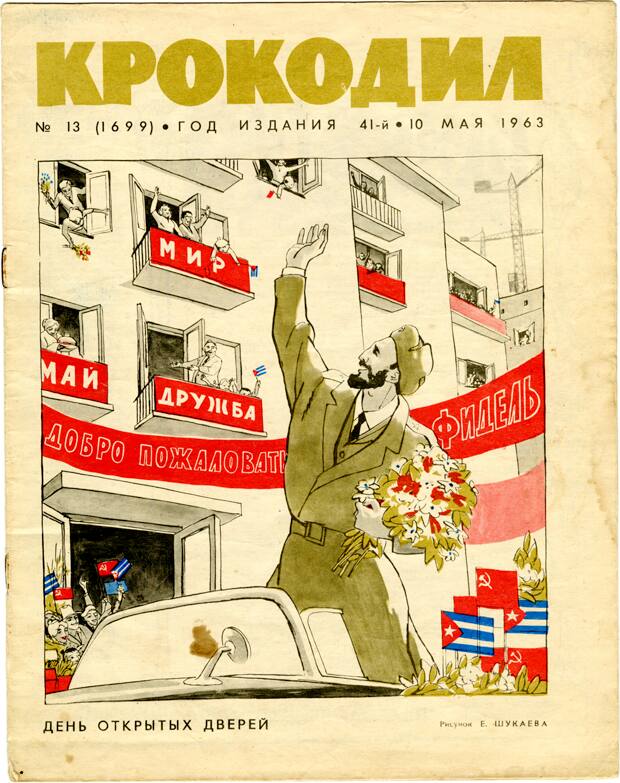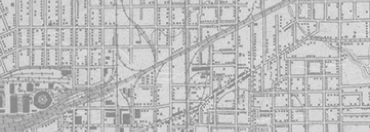


Back
Krokodil (Crocodile), a USSR newspaper magazine, with Fidel Castro on the cover
USSR newspaper magazine titled Krokodil, which translates to "Crocodile" in English, published 03/10/1963; cover features an illustration of Fidel Castro waving to crowds along a parade route.The magazine is in Russian, issue No. 13, and is 15 pages. Its publication coincided with Castro's visit to the Soviet Union.The cover shows a triumphant Castro. Cuban and Soviet flags are drawn behind the vehicle and some onlookers also wave those flags. Several people are drawn standing on balconies holding flags and flowers and cheering for Castro. Some of the balconies have red banners hanging off them; translated, those read: "Peace, May, Friendship". A large red banner across the middle translates to "Welcome, Fidel". Beneath the illustration it says "Open House" in black text. The artist's name is printed in the lower right corner under the image: "E. Shukayev". Translation assistance for this object was sought from a native Russian speaker.This image is not available online larger than a thumbnail to protect the copyright of its creator(s). For a more detailed examination of this item, please schedule an appointment in the Museum’s Reading Room.
Krokodil (Crocodile), a USSR newspaper magazine, with Fidel Castro on the cover
03/10/1963
Newsprint
12 7/8 × 10 3/16 in. (32.7 × 25.9 cm)
The Sixth Floor Museum at Dealey Plaza Collection
2018.039.0001
The dignified and heroic figure of Castro on the cover of this Russian publication is a far cry from the satirical representations of him in American publications (see 2000.043.0001, 2018.040.0001 and 2018.041.0001) from the same time period. During the height of the Cold War, one of the most common ways to downplay the potential threat Fidel Castro represented was to depict him as silly, a follower, or a blustering bully. It was far more common in America to see a caricature of Castro during those years than to see anything like this Russian depiction. - Lindsey Richardson, Curator of Collections

Krokodil (Crocodile), a USSR newspaper magazine, with Fidel Castro on the cover
USSR newspaper magazine titled Krokodil, which translates to "Crocodile" in English, published 03/10/1963; cover features an illustration of Fidel Castro waving to crowds along a parade route.The magazine is in Russian, issue No. 13, and is 15 pages. Its publication coincided with Castro's visit to the Soviet Union.The cover shows a triumphant Castro. Cuban and Soviet flags are drawn behind the vehicle and some onlookers also wave those flags. Several people are drawn standing on balconies holding flags and flowers and cheering for Castro. Some of the balconies have red banners hanging off them; translated, those read: "Peace, May, Friendship". A large red banner across the middle translates to "Welcome, Fidel". Beneath the illustration it says "Open House" in black text. The artist's name is printed in the lower right corner under the image: "E. Shukayev". Translation assistance for this object was sought from a native Russian speaker.This image is not available online larger than a thumbnail to protect the copyright of its creator(s). For a more detailed examination of this item, please schedule an appointment in the Museum’s Reading Room.
Krokodil (Crocodile), a USSR newspaper magazine, with Fidel Castro on the cover
03/10/1963
Magazines
Cold War
Russia
Cuba
Soviet Union
Cartoon
Political cartoons
Castro, Fidel
КРОКОДИЛ
Newsprint
12 7/8 × 10 3/16 in. (32.7 × 25.9 cm)
The Sixth Floor Museum at Dealey Plaza Collection
2018.039.0001
The dignified and heroic figure of Castro on the cover of this Russian publication is a far cry from the satirical representations of him in American publications (see 2000.043.0001, 2018.040.0001 and 2018.041.0001) from the same time period. During the height of the Cold War, one of the most common ways to downplay the potential threat Fidel Castro represented was to depict him as silly, a follower, or a blustering bully. It was far more common in America to see a caricature of Castro during those years than to see anything like this Russian depiction. - Lindsey Richardson, Curator of Collections









